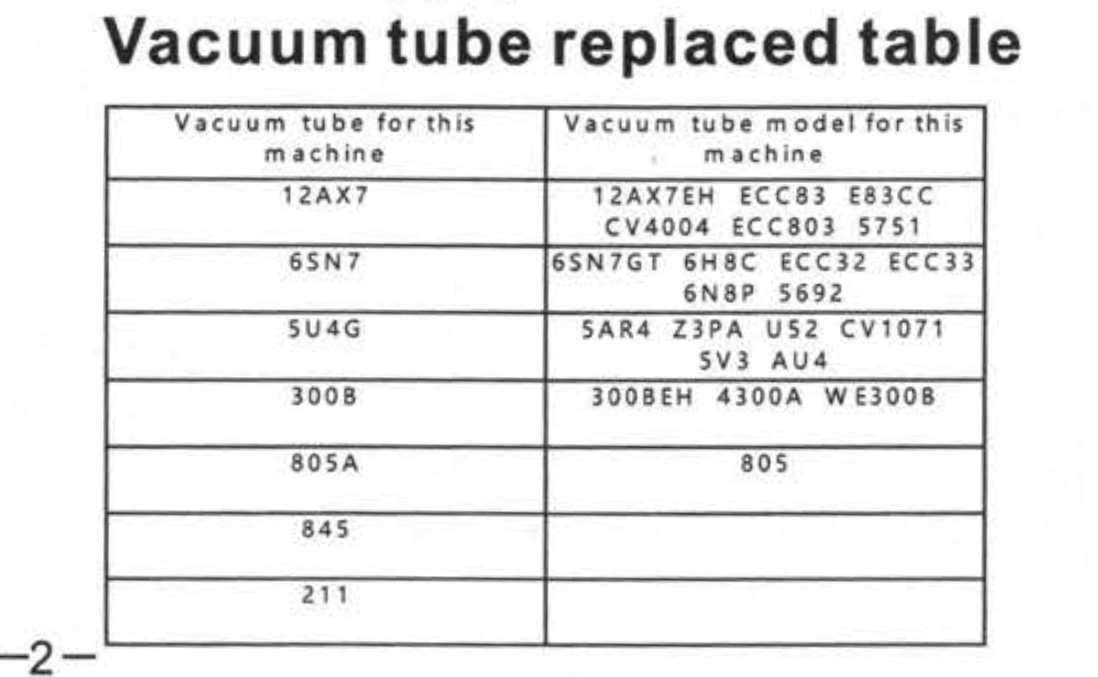What @mulveling and @lowrider57 said excellent info!
6SN7 GT instead of GTA/B?
I´ve been using the Willsenton R-800i for a while now and I´m very happy with it. I´ve been tube rolling a bit and in the 6SN7 position I kept putting GTA or GTB tubes. They sound nice.
Now I had a look at the manual again which doesn´t list these at all and instead focuses on GT or ECC32 or (afaik even more different) ECC33.

Being a total amateur when it comes to electronics I´m wondering if tubes with varying specifications (6SN7 GT vs GTA/B vs ECC32 vs ECC33) affect the tubes further down the chain. Without having any insight into the working of tube amps I´m inclined to say yes of course. But do they really do so in a significant way? Effects of different brands aside, what can the effect be on sound and on the 300B and 805?
If for example I had a pair of 6SN7 GTs (filament voltage Vf 6.3 Volts / If 0.6 Ampere) – the Willsenton is using one tube for each chanel in that position – and replaced them with ECC33s (Vf 6.3 Volts / If 0.95 Ampere) that sound exactly the same, wouldn´t the other tubes and by this the sound be affected?
Maybe I´m complicating things, but ever since I saw this it´s been bugging me.
When buying vintage tubes, always request noise testing, especially with the older GT version. 6SN7's tend to be more microphonic or noisy than other small signal tubes.
@mulveling +1. Great info. |
@mulveling Thanks for the explanation! That´s very helpful! I basically take from it that the amp is able to use them all, which is great. And easy to keep in mind when looking for possible replacements. I did find some Mullard ECC33s and I´m tempted to give them a try. I recently also came across some GTs at a reasonable price, I think I will buy a nice pair next time.
|
If the older 6SN7GT spec is safe in an amp, then it is ALWAYS safe to use 6SN7GTA or 6SN7GTB in those same slots. The later GTA and GTB versions of 6SN7 are exactly the same as GT, but with higher ratings for plate voltage and dissipation (this means they’re more robust). The REVERSE is not always true. If an amp calls specifically for 6SN7GTA/GTB, you might be straining old GT tubes by running them in that slot - just depends on the amp. Quite honestly they’ll still probably work fine, but will wear out quicker. Note that for audio purposes, GTA and GTB are exactly the same. Also the GTA & GTB versions typically have less issues with noise & microphony than old tubes GT. On the flip side, the old GT tubes are usually known to sound "sweeter". In a preamp or phono stage, the old 1940s GT tubes are usually going to be too noisy, but in a power amp they’re fine (and IMO that's where 6SN7 belong!). The modern Russian Tung-Sol 6SN7 is a GTB, which is handy in amps that call for GTA/GTB. In some amps (like my VACs) it’s popular to call for GTA/GTB in the driver (V2) slots, and run them at higher voltages than in V1. In my VACs I like running old GT’s in V1 but stick to the called for GTA/GTB in V2 (the modern Russian tubes are actually FATASTIC in this role). Subs like the ECC33 must be done more cautiously, because the extra heater current draw is significant. However, if the manufacturer says OK, it should be fine. It’s an extra strain on the transformer in the PSU, but it that’s safely within limits (you basically add up the current draw amperage from all tubes and check if the transformer is rated to supply that), it will NOT affect the downstream tubes other than contributing its own unique sonics. Also watch out for 5692, which some people like to sub for 6SN7 (red base RCA and GE being popular). This tube has much lower plate ratings than even 6SN7GT. If you put this tube in a GTA/GTB slot it can be bad news! This tube is famed for its purported "10,000 hour life" but it won’t last for long if run way beyond its ratings! They ARE very mechanically rugged, though! |

